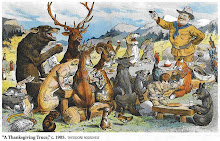Dr. Amanda Sparkman's groundbreaking research to be featured
Trent University post-doctoral research fellow Dr. Amanda Sparkman shared her research on cooperative breeding in red wolf packs with Bob MacDonald of CBC Radio's Quirks & Quarks recently.
Dr. Sparkman's research was based on a dataset made available through her work with Trent University's Dr. Dennis L. Murray, associate professor in the Department of Biology and Canada research chair in terrestrial ecology. As a member of the red wolf recovery team, Prof. Murray has access to some very rare data which Dr. Sparkman used to conduct her cutting-edge research.
Lifespan data on these species is quite rare and Dr. Sparkman's paper, published in Proceedings of the Royal Society B in October of this year, is the first to examine the lifetime costs and benefits of helpers, revealing some unexpected and interesting findings pertaining to size and life expectancy."Males are generally larger than females, but especially larger in the presences of helpers, Dr. Sparkman suggests. "In the females' case," she says, "they seem to struggle as the population increases due to more competition for resources."
"More research is needed," Dr. Sparkman says, "but the study suggests that increased size leads to advanced rate of aging and that males may die earlier than females, shortening their reproductive lifespan and number of reproductive events."
As the first paper to examine the costs and benefits of cooperative breeding on lifetime reproduction, Dr. Sparkman's study will positively affect future efforts to manage the red wolf population and prevent extinction. "Any understanding of the basic biology of the red wolf, especially social behaviour, can contribute to managing the system," she says. "With this knowledge we can take care not to disrupt their family group and the positive roles helpers play in their reproductive lives."
Dr. Sparkman hails from California and completed an undergraduate degree at Westmont College in Santa Barbara and a Ph.D. at Iowa State University. She was attracted to Trent University's reputation for excellence in wildlife research. "Trent is a great centre for wolf research in North America," she says. "I have an excellent job. I really appreciate being able to work with this red wolf data set and with Dr. Murray. Having access to twenty years of data means you can ask a lot of questions." Her study is garnering national and international media attention.
____________________________________
Abstract of full Article found in Royal Society B
The evolutionary maintenance of cooperative breeding systems is thought to be a function of relative costs and benefits to breeders, helpers and juveniles. Beneficial effects of helpers on early-life survivorship and performance have been established in several species, but lifetime fitness benefits and/or costs of being helped remain unclear, particularly for long-lived species. We tested for effects of helpers on early- and late-life traits in a population of reintroduced red wolves (Canis rufus), while controlling for ecological variables such as home-range size and population density.
We found that the presence of helpers in family groups was positively correlated with pup mass and survival at low population density, but negatively correlated with mass/size at high density, with no relation to survival.
Interestingly, mass/size differences persisted into adulthood for both sexes.
While the presence of helpers did not advance age at first reproduction for pups of either sex, females appeared to garner long-term fitness benefits from helpers through later age at last reproduction, longer reproductive lifespan and a greater number of lifetime reproductive events, which translated to higher lifetime reproductive success.
In contrast, males with helpers exhibited diminished lifetime reproductive performance. Our findings suggest that while helper presence may have beneficial short-term effects in some ecological contexts, it may also incur long-term sex-dependent costs with critical ramifications for lifetime fitness.










No comments:
Post a Comment